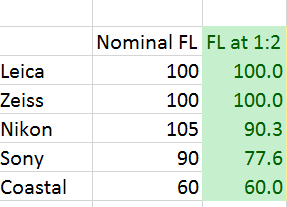This is a continuation of testing of the following macro lenses :
- Sony 90mm f/2.8 FE Macro
- Leica 100mm f/2.8 Apo Macro-Elmarit-R
- Zeiss 100mm f/2 Makro-Planar ZF
- Nikon 105mm f/2.8 Micro-Nikkor G VR
The test starts here:
The Nikon and the Sony lenses are internal focusing lenses, which means they change their focal length with distance.
I wanted to measure the change. I started out by making a big assumption: that the thin lens formula would be a reasonable approximation.
That formula is 1/i + 1/o = 1/f, where i is the distance from the center of the lens to the sensor (the image distance), o is the distance from the lenster of the lens to the object (the object distance) and f is the focal length of the lens (the distance from the center of the lens to the sensor when the lens is focused on infinity.
If r is the reduction factor (r = 1 means life size, r = 2 means half size, etc.), and d is the distance from the object to the sensor, then we know two things about o and i:
i = d – o
o = r * i
plugging those into the lens equation above and solving for f, I got:
f = d *r / (1+r)^2
So, at 1:1, f = d/4, and at 2:1, f = 2*d/9.
I set the lenses at the distance marked 1:2 on their barrels, focused on the razor blade, measured the distance from the blade to the sensor mark on the top of the camera, and this is what I got:
Then I added 1:1 for the lenses that could focus that close:
There’s something going on in the two internal focusing lenses besides just leaving the bulk of the lens alone and changing the focal length to focus. If we apply the thin lens equation to that situation, we get the focal length of the lens to be:
f = r * F / (1+r)
where F is the focal length at infinity, and r is the reduction ratio as defined above. For r = 2, the above equation evaluates to 2*F/3, which would say that the 90mm Sony would be a 60mm lens at 1:2. It is actually more like a 78mm lens.


Right!
I had done back of the envelopes using tlf on what I should expect with a fully IF 90mm when I got my Sony, and was surprised (and pleased) that it seemed to give slightly more working distance than I expected…
The other thing, which I have not measured or really tested, is that focus stacking using exposures adjusted with the ring rather than the rail (just the smallest amount I can manage) seem to align a bit better than I feared with IF..
Hi Jim
Does this also happens to internal zooming lenses vs external zooming lenses?
It’s known that Sony 200-600 G is not a true 600 mm FL when focused in the inmediacies of its minimum focus distance.
On the other hand I have seen some reviews of the Sigma 150-600 DG DN Sports and recently the new Sigma 60-160 DG DN Sports where both -equiped with external zoom mechanisms- at any focal lenght have a bigger magnification ratio than the same focal lenghts in the Sony -internal zoom system-.
https://www.youtube.com/watch?v=IIZLIm44ztI
Minute 5:30 and 5:51
Best regards.
I’m unfamiliar with the lenses you mentioned. I’ve not performed this kind of test on a zoom lens, so I don’t know the answer to your question. There are some zoom lenses that have a close-focus range. I would guess that they might shorten the focal length in that range, but I don’t really know. I’ve never had any desire to use a zoom for macro work.
Well, certainly that question was not related to macro work but somewhat related to changes in focal lenght due to external zoom designs vs internal zoom ones. I asked because it seemed to me that could there be some connection to your tests and maybe you had some experience about it.
It’s not easy to find info about this issue.
What I’m trying to find an answer/explanation is if near to minimum focus distance external zoom lenses effectively show the real focal lenght marked on the barrel while internal zoom lenses show lesser focal lenght than what is marked on the barrel.
Thanks in any case
Best regards
You normally see the changes in focal length the most at close focus distance. That’s why I mentioned macro.
Thanks Jim